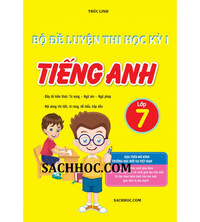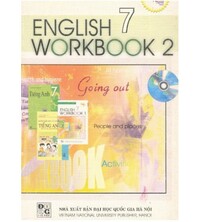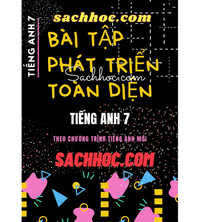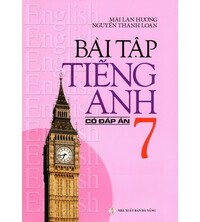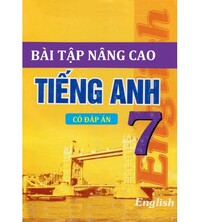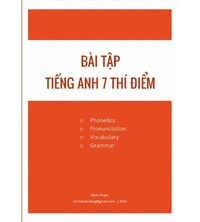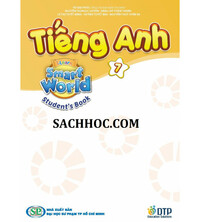Đề thi kì 1 môn tiếng Anh lớp 7 năm 2019 - 2020 phòng GD-ĐT Lấp Vò
Giải chi tiết đề thi kì 1 môn tiếng Anh lớp 7 năm 2019 - 2020 phòng GD-ĐT Lấp Vò với cách giải nhanh và chú ý quan trọng
Đề bài
|
PHÒNG GIÁO DỤC VÀ ĐÀO TẠO HUYỆN LẤP VÒ
Mã đề thi 513 |
ĐỀ THI HỌC KÌ I NĂM HỌC 2019-2020 Môn thi: TIẾNG ANH – KHỐI 7 Thời gian làm bài: 60 phút
|
SECTION A (6.0 points)
Listen to a short talk tiwce and choose the best answer for each of the following questions. Write your answers on the answer sheet.
Question 1 (NB). What is Sarah's hobby?
A. writing B. eating
C. reading D. fishing
Question 2. (NB) When did she start her hobby?
A. five years old B. four years old
C. six years old D. fourteen years old
Question 3. (TH) According to Sarah, what are the advantages of her hobby?
A. Both B &C are right
B. learn the culture and customs of other countries
C. give an unlimited imagination
D. interested
Question 4. (VD) What will she be able to do in the future?
A. can improve her English
B. can read “Harry Potter”
C. can read challenging books.
D. can write books
Listen to a short talk about volunteering and decide whether the following sentences are True (T) or False ( F). Write your answer on your answer sheet.
Question 5. (VD) Volunteering is useful for your future job.
Question 6. (TH) You can earn money from volunteering and learn some social skills.
Question 7. (TH) Volunteering can only help homeless, children to Icarn English, arts.
Question 8. (TH) Volunteers help children with healthy problems and disable children.
Write the letter A, B, C, or D on your answer sheet to indicate the word whose underlined part differs from the other three in pronunciation in each of the following questions.
Question 9. (TH)
A. exhibition B. collection
C. question D. tradition
Question 10. (NB)
A. school B. children
C. chair D. watch
Write the letter A, B, C, or D on your answer sheet to indicate the word that differs from the other three in the position of primary stress in cach of the following questions.
Question 11. (NB)
A. donate B. regard
C. compose D. visit
Write the letter A, B, C, or D on your answer sheet to indicate the correct answer to each of the following questions.
Question 12. (NB) I don’t speak French and Sarah doesn't speak French, _____.
A. either B. too
C. so D. neither
Question 13. (NB) Minh enjoys _______ a bike on the weekend.
A. ride B. to ride
C. rides D. riding
Question 14. (NB) Last year, we ______ evening classes for fifty children.
A. providing B. provided
C. have provided D. to provide
Question 15. (TH) Have you got ______ sandwiches in your fridge?
A. some B. any
C. a D. an
Question 16. (TH) How ____ milk do you need for breakfast?
A. far B. often
C. many D. much
Question 17. (TH) These people live in the countryside, _____ they enjoy the fresh air here.
A. so B. or
C. but D. and
Write the letter A, B, C or D on your answer sheet to indicate the word(S) CLOSET in meaning to the underlined word(s) in each of the following questions.
Question 18. (VD) The puppeteers skillfully control the puppets of the performances.
A. shows B. pictures
C. art D. music
Write the letter A, B, C or D on your answer sheet to indicate the word(S) OPPOSITE in meaning to the underlined word(s) in each of the following questions.
Question 19. (VD) Kathy finds carving the wood interesting.
A. easy B. difficult
C. fantastic D. boring
Write the letter A, B, C or D on your answer sheet to indicate the underlined part that needs correction in each of the following questions.
Question 20. (TH) Transport in my village now is different as that in the past.
A. is B. that
C. in D. as
Question 21. (VD) There is some rice, but there isn’t a meat for luch.
A. some B. but
C. for D. a
Question 22. (TH) We have donate used books to many poor students at my school so far.
A. many B. at
C. donate D. far
Read the following passage and write the letter A, B, C or D on your answer sheet to indicate the correct word or phrase that best fits each of the numbers blanks.
Water puppetry is a traditional art form. It (23) _____ in the 11th century. It originated in the villages of the Red River Delta of North Viet Nam. The show is performed in a (24) ____. The puppets are supported by strings (25) _____ the water and controlled by the puppeteers behind a screen, so they appear to be moving on the water. the puppets are made of (26) ____ and then painted. The themes of the puppets shows are rural: the performances show everyday life in the countryside and folk tales. There are about rice farming, fishing and Vietnamese village festivals.
Question 23. (NB)
A. begin B. has begun
C. began D. have begun
Question 24.(VD)
A. pool B. well
C. river D. stream
Question 25. (TH)
A. at B. under
C. on D. to
Question 26. (TH)
A. paper B. tree
C. metal D. wood
Read the following passage and write the letter A, B, C or D on your answer sheet to indicate the correct answer to each of the question.
There are many kinds of musicat instrument and people listen to music all over the world. They turn on music in parties, clubs, weddings and restaurants as well. People like music because it helps them forget sadness and makes them feel more love in life. After a hard working day, people come back home and feel so tired. Music now can help them close their eyes and relax themselves. Sometimes it is difficult to understand music, but people still enjoy it.
Question 27. (NB) Do people listen to music all over the world?
A. Yes, they are B. Yes,they do
C. No,they don't D. No, they aren’t
Question 28. (NB) Where do they turn on music?
A. in weddings in restaurants
B. in clubs and weddings
C. in parties and clubs
D. in parties, clubs, weddings and restaurants
Question 29. (TH) The words “sadness” in line 3 means ______.
A. relax feeling B. funny feeling
C. unhappy feeling D. safe feeling
Question 30. (NB) How do people feel after a hard working day?
A. tired B. can close their eyes
C. relax themselves D. easy to sleep
SECTION B (2,0 points)
I. Finish each of the following Sentences in such a way that it means the same as the sentence printed before it, Write your answers on your answer sheet. (0,5 point)
Question 1. (VD) I think action films are more exciting than romantic films.
=> In my opinion, romantic films are _________.
Question 2. (VD) Tom is interested in cating Vietnamese food.
=> Tom likes _______.
II. Write a paragraph (about 60-80 words) on the following topic.
The volunteer works that you want to do to help the community.
You can refer to the following factors:
- What volunteer works you want to do (donate books, food, drink/do housework/keep the
street clean.)
- Who you want to help (street children/elderly people/poor/homeless people...)
- Why you want to do them (know how to read and write/be happier/get over the
difficulty…)
- How you do to help (making postcards for selling/cooking meals/collect the rubbish...)
- Who can help you do (friends/family/relatives/neighbours/the rich/businessmen… )
- How you feel about your works (meaningful/usefuhappy/easy/difficult/interesting…)
------------------THE END------------------
Lời giải chi tiết
HƯỚNG DẪN GIẢI
Thực hiện: Ban Chuyên môn
|
9C |
15B |
21D |
27B |
|
10A |
16D |
22C |
28D |
|
11D |
17D |
23C |
29C |
|
12A |
18A |
24A |
30A |
|
13D |
19D |
25B |
|
|
14B |
20D |
26D |
|
Question 31. In my opinion, romantic films are not as exciting as action films.
Question 32. Tom likes eating Vietnamese food.
LỜI GIẢI CHI TIẾT
Question 9. C
Kiến thức: Phát âm đuôi “-tion)
Giải thích:
exhibition /ˌek.sɪˈbɪʃ.ən/
collection /kəˈlek.ʃən/
question /ˈkwes.tʃən/
tradition /trəˈdɪʃ.ən/
Đáp án C đọc là / tʃən/ còn lại là /ʃən/
Chọn C
Question 10. A
Kiến thức: Phát âm “-ch”
Giải thích:
school /skuːl/
children /ˈtʃɪl.drən/
chair /tʃeər/
watch /wɒtʃ/
Đáp án A phần gạch chân đọc là /k/ còn lại là /tʃ/
Chọn A
Question 11. D
Kiến thức: Trọng âm với từ có 2 âm tiết
Giải thích:
donate /dəʊˈneɪt/
regard /rɪˈɡɑːd/
compose /kəmˈpəʊz/
visit /ˈvɪz.ɪt/
Đáp án D trọng âm rơi vào âm tiết thứ nhất còn lại là thứ 2
Chọn D
Question 12. A
Kiến thức: Cấu trúc câu đồng tình với too và either
Giải thích:
Đồng tình trong câu khẳng định => dùng too
Đồng tình trong câu phủ định => dùng either.
Trong câu hỏi trên cả 2 vế đều dùng dạng phủ định => either.
=> I don’t speak French and Sarah doesn't speak French, either.
Tạm dịch: Tôi không nói Tiếng Pháp và Sarah cũng vậy.
Chọn A
Question 13. D
Kiến thức: Động từ diễn tả sự yêu thích + V-ing
Giải thích:
enjoy + V-ing: thích làm gì
=> Minh enjoys riding a bike on the weekend.
Tạm dịch: Minh thích đi xe đạp vào cuối tuần.
Chọn D
Question 14. B
Kiến thức: Thì quá khứ đơn
Giải thích:
Dấu hiệu nhận biết thì quá khứ đơn: last year => động từ thêm –ed hoặc biến đổi
provide => provided
=> Last year, we provided evening classes for fifty children.
Tạm dịch: Năm ngoái, chúng tôi mở lớp học tối cho 50 trẻ em,
Chọn B
Question 15. B
Kiến thức: Mạo từ
Giải thích:
Đối với câu hỏi hoặc câu phủ định thì có thể sử dụng any: bất kể + N(đếm được/không đếm được)
=> Have you got any sandwiches in your fridge?
Tạm dịch: Bạn có bánh san-wich nào trong tủ lạnh không?
Chọn B
Question 16. D
Kiến thức: Câu hỏi với từ để hỏi
Giải thích:
Các loại câu hỏi với How
How far: bao xa (hỏi khoảng cách)
How often: Bao lâu (chỉ tần suất)
How many + N(đếm được số nhiều): Bao nhiêu
How much + N(không đếm được): Bao nhiêu
milk là danh từ không đếm được
=> How much milk do you need for breakfast?
Tạm dịch: Bạn cần bao nhiêu sữa cho bữa sáng?
Chọn D
Question 17. D
Kiến thức: Từ nối
Giải thích:
so: do đó
or: hoặc là
but: nhưng
and: và
=> These people live in the countryside, and they enjoy the fresh air here.
Tạm dịch: Những người này sống ở vùng quê và họ thích không khí trong lành ở đây.
Chọn D
Question 18. A
Kiến thức: Từ vựng
Giải thích:
performances (n): các màn trình diễn (danh từ số nhiều => từ tương ứng cũng phải là 1 danh từ số nhiều)
performances = shows
=> The puppeteers skillfully control the puppets of the shows.
Tạm dịch: Nghệ nhân rối nước điều khiển những con rối một cách khéo léo trong các màn trình diễn.
Chọn A
Question 19. D
Kiến thức: Từ vựng
Giải thích:
interesting (adj): thú vị >< boring (adj): nhàm chán
Tạm dịch: Kathy thấy khắc gỗ rất thú vị
Chọn D
Question 20. D
Kiến thức: Giới từ
Giải thích:
A is different from B: A khác B
=> Transport in my village now is different from that in the past.
Tạm dịch: Giao thông ở làng tôi hiện tại rất khác với quá khứ.
Chọn D
Question 21. D
Kiến thức: Mạo từ
Giải thích:
Trong câu phủ định thì nên sử dụng any thay vì “a” mà “a” lại là mạo từ đi cùng với danh từ số ít đếm được mà meat là danh từ không đếm được nên không được sử dụng.
=> There is some rice, but there isn’t any meat for luch.
Tạm dịch: Có một ít gạo, nhưng không có thịt cho bữa trưa.
Chọn D
Question 22. C
Kiến thức: Thì hiện tại hoàn thành
Giải thích:
Cấu trúc thì hiện tại hoàn thành: S + have/has + Vp2
Trong đó Vp2 là động từ (quá khứ phân từ) chia ở cột thứ 3
donate => donated
=> We have donated used books to many poor students at my school so far.
Tạm dịch: Chúng tôi đã quyên góp sách đã qua sử dụng cho rất nhiều trẻ em nghèo ở trường.
Chọn C
Question 23. C
Kiến thức: Thì quá khứ đơn
Giải thích:
Dấu hiệu của thì quá khứ đơn diễn tả 1 sự kiện trong quá khứ: in + time
=> Water puppetry is a traditional art form. It began in the 11th century.
Tạm dịch: Múa rối nước là một hình thức nghệ thuật truyền thống. Nó bắt đầu vào thế kỉ 11.
Chọn C
Question 24. A
Kiến thức: Từ vựng
Giải thích:
pool: hồ nước
well: giếng
river: sông
stream: suối
=> It originated in the villages of the Red River Delta of North Viet Nam. The show is performed in a pool.
Tạm dịch: Nó được bắt nguồn ở những ngôi làng của đồng bằng sông Hồng ở phía Bắc Việt Nam. Màn trình diễn được tổ chức tại 1 cái hồ.
Chọn A
Question 25. B
Kiến thức: Giới từ
Giải thích:
under: bên dưới
=> The puppets are supported by strings under the water and controlled by the puppeteers behind a screen..
Tạm dịch: Những con rối được hỗ trợ bởi các dây dưới nước và được điều khiển bởi những con rối đằng sau màn.
Chọn B
Question 26. D
Kiến thức:
Giải thích:
paper: giấy
tree: cây
metal: kim loại
wood: gỗ
made of sth: được làm bằng (nguyên liệu gì)
=> The puppets are made of wood and then painted.
Tạm dịch: Những con rối được làm bằng gỗ và sau đó sơn.
Chọn D
Dịch bài đọc:
Múa rối nước là một loại hình nghệ thuật truyền thống. Nó bắt đầu vào thế kỷ thứ 11. Nó bắt nguồn từ những ngôi làng thuộc đồng bằng sông Hồng của Bắc Việt Nam. Chương trình được thực hiện trong một hồ bơi. Những con rối được hỗ trợ bởi các dây dưới nước và được điều khiển bởi những con rối đằng sau màn, vì vậy chúng dường như đang di chuyển trên mặt nước. Những con rối được làm bằng gỗ và sau đó sơn. Các chủ đề của các chương trình múa rối là nông thôn: các buổi biểu diễn cho thấy cuộc sống hàng ngày ở nông thôn và những câu chuyện dân gian. Có về trồng lúa, câu cá và lễ hội làng của người Việt.
Question 27. B
Giải thích:
Câu hỏi: “Có phải mọi người nghe nhạc trên toàn thế giới phải không?”
Câu hỏi yes-no question với trợ động từ đứng đầu là “do” nên khi trả lời cũng phải dùng trợ động từ này.
Thông tin: (Câu đầu) There are many kinds of musical instrument and people listen to music all over the world.
Tạm dịch: Có nhiều loại nhạc cụ và mọi người nghe âm nhạc trên toàn thế giới.
Chọn B
Question 28. D
Giải thích:
Câu hỏi: Họ mở nhạc ở đâu?
A. ở đám cưới trong nhà hàng
B. ở câu lạc bộ và đám cưới
C. ở tiệc và câu lạc bộ
D. ở bữa tiệc, câu lạc bộ, đám cưới và nhà hàng
Thông tin: They turn on music in parties, clubs, weddings and restaurants as well
Tạm dịch: Họ cũng bật nhạc trong các bữa tiệc, câu lạc bộ, đám cưới và nhà hàng
Chọn D
Question 29. C
Giải thích:
Từ “sadness” ở dòng thứ 3 có nghĩa là gì?
A. cảm xúc thoải mái
B. cảm xúc vui vẻ
C. cảm xúc không vui
D. cảm xúc an toàn
sadness (n): sự buồn bã
Thông tin: People like music because it helps them forget sadness and makes them feel more love in life.
Tạm dịch: Mọi người thích âm nhạc vì nó giúp họ quên đi nỗi buồn và khiến họ cảm thấy yêu đời hơn.
Chọn C
Question 30. A
Kiến thức:
Giải thích:
Câu hỏi: mọi người cảm thấy thế nào sau 1 ngày làm việc chăm chỉ?
A. mệt mỏi
B. có thể nhắm mắt
C. tự cảm thấy thoải mái
D. dễ ngủ
Thông tin: After a hard working day, people come back home and feel so tired.
Tạm dịch: Sau một ngày làm việc vất vả, mọi người trở về nhà và cảm thấy vô cùng mệt mỏi.
Chọn A
Dịch bài đọc:
Có nhiều loại nhạc cụ và mọi người nghe âm nhạc trên toàn thế giới. Họ cũng bật nhạc trong các bữa tiệc, câu lạc bộ, đám cưới và nhà hàng. Mọi người thích âm nhạc vì nó giúp họ quên đi nỗi buồn và khiến họ cảm thấy yêu đời hơn. Sau một ngày làm việc vất vả, mọi người trở về nhà và cảm thấy vô cùng mệt mỏi. Âm nhạc bây giờ có thể giúp họ nhắm mắt và thư giãn. Đôi khi rất khó để hiểu âm nhạc, nhưng mọi người vẫn thích nó.
SECTION B:
Question 31.
Kiến thức: So sánh ngang bằng/không ngang bằng
Giải thích:
Sử dụng cấu trúc so sánh không ngang bằng: S1 + to be (not) + as adj as + S2
trong đó: động từ to be là are (đã cho)
adj: exciting
S2: action films
Đáp án: In my opinion, romantic films are not as exciting as action films.
Tạm dịch: Theo ý kiến của tôi thì phim lãng mạn không hay bằng phim hành động.
Question 32.
Kiến thức: Cấu trúc với like
Giải thích:
to be interested in V-ing = like V-ing: thích làm gì
=> Tom likes eating Vietnamese food.
Tạm dịch: Tom thích ăn đồ ăn của Việt Nam
II.
Đề bài: Viết đoạn văn khoảng 60-80 chữ về chủ đề sau:
Các công việc tình nguyện mà bạn muốn làm để giúp đỡ cộng đồng.
Bạn có thể tham khảo các yếu tố sau:
- Những công việc tình nguyện bạn muốn làm (tặng sách, thức ăn, đồ uống / làm việc nhà / giữ đường sạch sẽ.)
- Ai bạn muốn giúp đỡ (trẻ em lang thang / người già / người nghèo / người vô gia cư ...)
- Tại sao bạn muốn làm những việc đó (biết cách đọc và viết / hạnh phúc hơn / vượt qua
khó khăn…)
- Cách bạn làm để giúp đỡ (làm bưu thiếp để bán / nấu bữa ăn / thu gom rác ...)
- Ai có thể giúp bạn làm (bạn bè / gia đình / người thân / hàng xóm / người giàu / doanh nhân)
- Bạn cảm thấy thế nào về công việc của mình (có ý nghĩa / hữu ích / dễ dàng / khó khăn / thú vị)
Bài viết mẫu
I am interested in doing volunteer works to help the community. I usually donate books to street and poor children who don’t have conditions to go to school. Because of their poor living standard, they lack books, supplies and clothes. This is the reason why I want to give my hand by collecting used books from students around and give them to the poor students. I can encourage my friends join and carry the project with me. That must be a meaningful activity to help our community better.
----------THE END----------
Search google: "từ khóa + timdapan.com" Ví dụ: "Đề thi kì 1 môn tiếng Anh lớp 7 năm 2019 - 2020 phòng GD-ĐT Lấp Vò timdapan.com"

